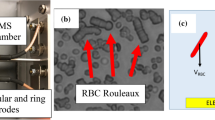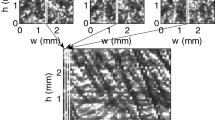Abstract
To investigate the temperature-dependence of red cell aggregation 20 blood samples of normal donors and 20 blood samples of patients with venous ulcers of the leg were examined by photometric aggregometry at 3° C, 10° C, 20° C, 30° C and 37° C. With decreasing temperature red cell aggregates become more resistant to hydrodynamic dispersion and they become more prone to growing under low shear stress. It is concluded that a decrease in temperature causes an increase in adsorptive energy of red cell aggregation, which is most likely due to an increase in molecular adsorption stress. Red cell aggregate formation as an overall process is retarded by a decrease in temperature, which is primarily due to an increase in plasma viscosity causing increased damping of aggregate formation. Accordingly the rate constant of aggregate formation corrected for plasma viscosity increases with decreasing temperature. The temperature-dependence of the kinetic parameters can be explained by a theoretical model that suggests the increase in contact area between aggregating red blood cells as the rate-limiting step of red cell aggregation. As a whole red cell aggregation is favoured by lowering of temperature.
Similar content being viewed by others
References
Brinkman R, Zijlstra WG, Jansonius NJ (1963) Quantitative evaluation of the rate of rouleaux formation of erythrocytes by measuring light reflection (“Syllectometry”). Proc Kon Ned Akad Wet Ser C 66:237–248
Chien S, (1976) Clumping (reversible aggregation and irreversible agglutination) of blood cellular elements. Electrochemical interactions between erythrocyte surfaces. Thromb Res (Suppl II) 8:189–202
Chien S, Sung LA, Kim S, Burke AM, Usami S (1973) Determination of the aggregation force in rouleaux by fluid mechanical technique. Microvasc Res 13:327–333
Chien S, Sinchon S, Abbott RE, Jan KM (1977) Surface adsorption of dextranes in human red cell membranes. J Colloid Interfac Sci 62:461–470
Easthope PL, Brooks DE (1980) A comparison of rheological constitutive functions for whole human blood. Biorheology 17:235–247
Harkness J (1963) A new instrument for the measurement, of plasma viscosity. Lancet II:280–281
Harkness J, Whittington RB (1970) Blood-plasma viscosity: an approximate temperature-invariant arising from generalized concepts. Biorheology 6:169–187
Klose HJ, Volger E, Brechtelsbauer L, Heinrich L, Schmid-Schönbein H (1972) Microrheology and light transmission of blood. I. The photometric effect of red cell aggregation and red cell orientation. Pflügers Arch 333:126–130
McMillan DE, Utterback NG, Mitchell TP (1983) Diabetic erythrocyte doublet formation: a model of impaired membrane viscous deformation. (Abstr) Biorheology 20:428
Merrill EW (1969) Rheology of blood. Physiol Rev 49:963–988
Merrill EW, Cokelet G, Shin H, Britten A, Wells RE Jr (1963) Rheology of human blood near zero flow. Effects of temperature and hematocrit level. Biophys J 3:199–213
Mills P, Quemada D, Dufaux J (1980) Red blood cell aggregation and orientation studied by laser light backscattering. In: Stoltz, JF, Drouin P (eds) Hemorheology and diseases. Doin, Paris, pp 169–176
Neumann FJ (1985) Hämorheologische Befunde bei Patienten mit venösem Ulcus cruris unter besonderer Berücksichtigung der Temperaturabhängigkeit der Erythrozytenaggregation. Ein Beitrag zur Thermodynamik hämorheologischer Phänomene. MD Thesis, RWTH Aachen
Peters R (1981) Translational diffusion in the plasma membrane as studied by fluorescein microphotolysis. Cell Biol Int Rep 5:733–750
Platt HA, Cuba JU, Kaplan HS (1978) Initial studies on the temperature viscosity relationship of human plasma and serum. Biorheology 15:29–35
Schmid-Schönbein H, von Gosen J, Heinrich L, Klose HJ, Volger E (1973a) A counter-rotating “rheoscope chamber” for the study of the microrheology of blood cell aggregation by microscopic observation and microphotometry. Microvasc Res 6:366–376
Schmid-Schönbein H, Gallasch G, Volger E, Klose HJ (1973b) Microrheology and protein chemistry of pathological red cell aggregation (blood sludge) studied in vitro. Biorheology 10:213–227
Schmid-Schönbein H, Kline KA, Heinrich L, Volger E, Fischer TM (1975) Microrheology and light transmission of blood. III. The velocity of red cell aggregate formation. Pflügers Arch 354:299–317
Schmid-Schönbein H, Gallasch G, Von Gosen J, Klose HJ (1976) Red cell aggregation and blood flow. I. New methods of quantification. Klin Wochenschr 54:149–157
Skalak R, Zarda PR, Jan KM, Chien S (1978) Theory of rouleau formation. In: Jaffrin MY (ed) Cardiovascular and pulmonary dynamics. Euromech 92. INSERM, Paris, pp 299–308
Volger E, Schmid-Schönbein H, Von Gosen J, Klose HJ, Kline KA (1975) Microrheology and light transmission of blood. IV. Kinetics of artificial red cell aggregation induced by dextran. Pflügers Arch 354:319–337
Waugh R, Evans EA (1979) Thermoelasticity of red blood cell membrane. Biophys J 26:115–132
Weber H (1985) Hämorheologische Befunde bei Patienten mit Raynaud-Syndrom. MD Thesis, RWTH Aachen
Welch BL (1937) The significance of the difference between two means when the population variances are unequal. Biometrika 29:350–361
Author information
Authors and Affiliations
Additional information
Part of a thesis, M.D., D85 RWTH-Aachen
Rights and permissions
About this article
Cite this article
Neumann, F.J., Schmid-Schönbein, H. & Ohlenbusch, H. Temperature-dependence of red cell aggregation. Pflugers Arch. 408, 524–530 (1987). https://doi.org/10.1007/BF00585080
Received:
Accepted:
Issue Date:
DOI: https://doi.org/10.1007/BF00585080




